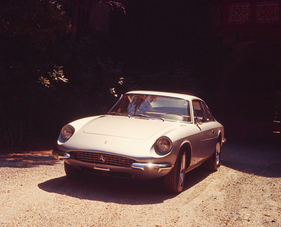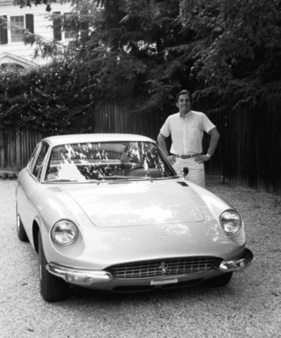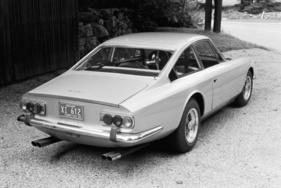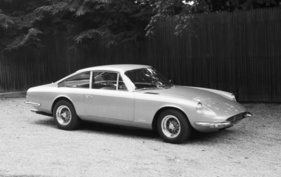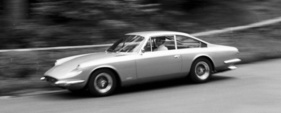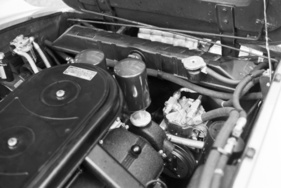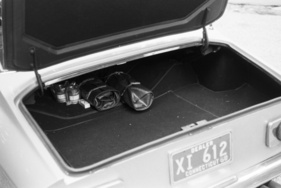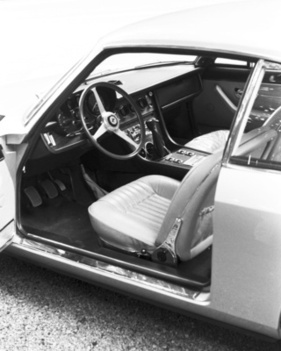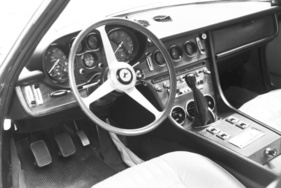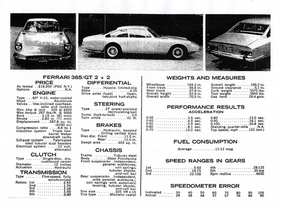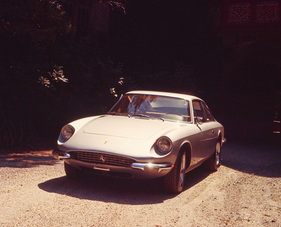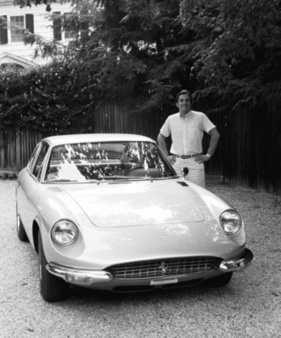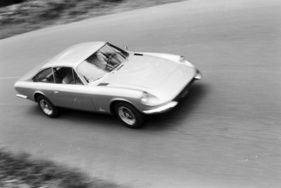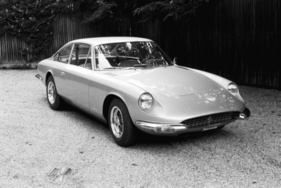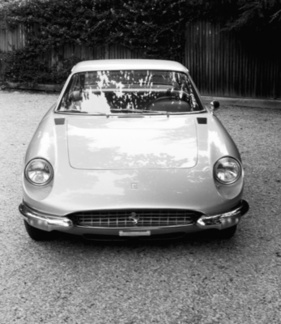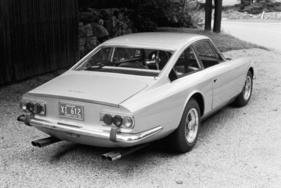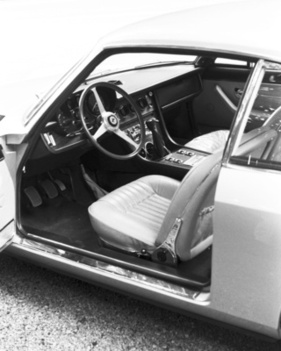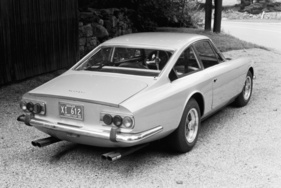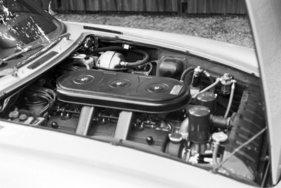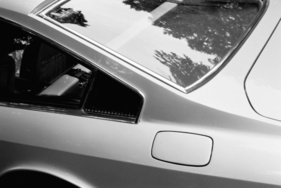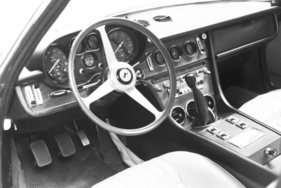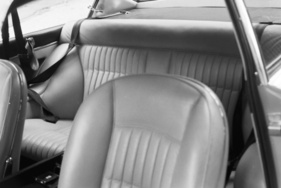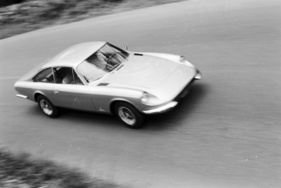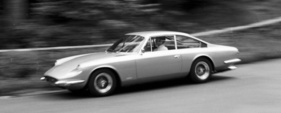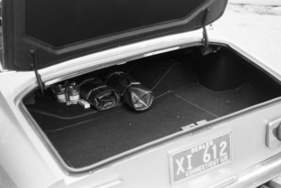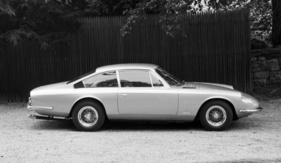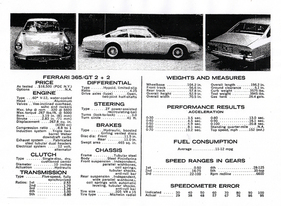Have you ever seen a good racing movie, like Grand Prix or Bruce Kessler's The Sound of Speed, where the camera is mounted on the front of the car? The road races towards you, twisting and turning past your movie seat. You are completely relaxed, and yet you have an enormous sense of speed - not because of your own movement, but because the world is rushing past your fixed position. And the noise level on the screen, the background music and all that doesn't prevent you from chatting easily and quietly with the person next to you in the cinema.
It's the same inside the Ferrari 365 GT 2+2 Coupé. With the air conditioning and the Blaupunkt radio, you can create your own atmosphere that is not disturbed by wind noise and is accompanied just right by the musical murmur of the V12 engine. All-round visibility is excellent, but from the front seat it's fantastic - unbelievably good, seemingly all the way to the tarmac under the nose of the car. In front of this high, curved screen, you can relax and enjoy the spectacle of the roads, trees, houses, hills and bridges without feeling uncomfortable - just like in a movie theater seat.
Of course, that's an exaggeration, but only a little. The new 2+2 is also a great car for passengers, because it drives so fast and so unagitated that even the most sensitive wife or girlfriend won't know or want to know how breathtakingly fast you're traveling. Two people can enjoy this feeling in sybaritic luxury; four people can experience it in somewhat reduced comfort. For a passenger, this new Ferrari is almost unrivaled in its lightness. For the driver, it is not as interesting as the sportier models, but still far more fascinating than most other cars you will drive in your lifetime.
Ferrari has several advantages over rivals such as Aston Martin, Iso, Maserati and Lamborghini. Firstly, the cars are actively used in motorsport by both the factories and private owners. You'll never see a 2+2 on the track, but it too embodies the sophistication of the racing versions of the 275 GTB/4. Secondly, Ferrari's long-standing and now intra-company collaboration with Pininfarina has given it the best coachwork in style and function and therefore the best cars in its class. If there is an equivalent to "Body by Fisher" in Europe, then it is a "Body by Pininfarina".
Frame and chassis
The 365 GT 2+2 is the most luxurious Ferrari ever produced, but also the heaviest - with the exception of some of the earliest Touring models. With a kerb weight of 1621 kg, it is heavier than a Mustang or Camaro and is on a par with the current US mid-size cars. With an engine displacement of just 4.4 liters, it won't be a spectacular performer - overhead camshafts or not - but its acceleration times are still quicker than a Toronado or Riviera, which is more than fast enough for American traffic.
A significant proportion of the weight is accounted for by the frame, a traditional Ferrari chassis made of large diameter tubes, which subsequently becomes an integral part of the bodywork. Independent rear suspensions are mounted on this frame for the first time on a production Ferrari. Independent rear suspension is problematic in a high-performance vehicle with potentially four passengers and corresponding luggage, as the toe and camber change depending on the load. In one of the first 365 GT prototypes, this problem was avoided by retaining a rigid rear axle.
However, the final rear suspension of the 2+2 has stronger wishbones and is much more robust than that of the lighter cars. Like the front wishbones, the rear ones are also made of forged steel and are stiffened by bolted-on steel pressed parts in the trapezoidal link. As in the Jaguar E-Type, but slightly further apart, there are two spring/damper units per side. The hydropneumatic Koni shock absorbers also allow the rear of the vehicle to be leveled so that the car always has the same suspension geometry, even when heavily loaded. This is a costly but effective way of perfecting independent rear suspension.
Stabilizers with a diameter of 20 mm are used at both the front and rear. The rear drive half-shafts have universal joints that allow axial movements. In early 2+2 prototypes, the magnesium disc wheels were still cupped; in the production model, the wheel flange is a few centimeters further out. Disc wheels are standard, Borrani-Record wire wheels with 7.5-inch rims, as on our test car, are available as an option.
A tamed racing engine
The engine, designated by Ferrari as Type 245, is a bored-out (81 mm) version of the 330 GT engine (77 mm). This modification has proven its worth and has been used since 1965 for the engines of the Ferraris 365 P used in racing. In racing, the additional torque of the engine took a heavy toll on clutches and gearboxes. For the road, Ferrari initially built the engine for the short-lived 365 California, of which fewer than ten were built. Although significantly tamed, the engine was still a racing powerplant - high performance, but not quite suitable for everyday use.
In the 365 GT, the crankshaft drives the air conditioning compressor and the alternator via several belts. Another belt at the front of the left camshaft drives the pump for the ZF power steering. There is also space to drive a secondary air pump, which will probably be used in the "detoxified" engines expected later this year. Perhaps they will also be fitted with Marelli's electronic ignition, as is already installed in the Fiat Dino. Engine cooling is assisted by two large, electrically driven aluminum fans mounted in front of the radiator, which switch on automatically when the coolant temperature rises above 88 degrees Celsius.
Perfect form
The shape of the bodywork around all these units has more in common with the original 250 GT 2+2 than with its successor, the 330 GT 2+2, which featured a more rounded window line and made an unsuccessful attempt at a four-headlight face. The headlights of the latest car are unusual in that they look good both with and without transparent plastic covers.
Pininfarina had already realized some of the lines of the 365 GT 2+2, in particular the window surrounds and the concave rear end, on the 330 GTC Speciale, which was shown at the beginning of 1967. This also had a strongly concave rear window, which was of course not intended for the 2+2. Several 2+2 prototypes, which were built later in 1967 on the California chassis with a rigid axle, still had exposed parking and position lights. In the final design, which was presented in Paris at the end of 1967, Pininfarina had elegantly integrated them into the front bumpers.
The new luxury Ferrari is a good-looking car with a sharp longitudinal edge emphasizing the flanks. Large, round wheel cut-outs with flared wheel arches break up the surface below. The clean lines of the roof and rear window, which merge into an almost completely flat tailgate, are particularly successful. The trunk has a wide hatch, extends far forward and offers plenty of space. It is superbly finished and hides the spare wheel under a flat floor flap with two hooks that hold it up while the wheel is removed.
Interior and equipment
The thoughtfulness in detail is the best we have ever seen in a modern Italian car. On the inside of the rear left door pillar there are two lockable release levers, one for the trunk and one for the fuel filler cap on the left-hand side of the body. On the inside of the latter there is an additional pull loop for the trunk lid - a safety measure in the event that the main unlocking mechanism should fail. Other nice details are the very good-looking door handles flush-mounted in the bodywork and the black air outlet grilles at the rear corners of the engine compartment and behind the side windows. The permeability of the latter can be adjusted using nozzles on the inside of the roof rail.
Primitive, but almost unavoidable with the generous glass surfaces of the 365 GT, are the swing-out rear side windows, which provide additional ventilation. The fast and quiet electric drives for the door and triangular windows, whose controls are located on the center console, are much more elegant. The doors are wide and deep and provide good access to all four seats, which are divided into two clearly separated halves by the wide center console. There are two ashtrays and an automatic "Insertalite" cigarette lighter on the console.
Pininfarina has made the wood-planked console blend beautifully with the dashboard. The rev counter, speedometer and three instruments for oil pressure, oil temperature and water temperature sit in the driver's field of vision with a cover. Three further displays are located above the console above a row of seven toggle switches with an illuminated row of code letters for the respective function. Below this is space for the radio and the three air conditioning outlets. In the middle of the outer two are buttons for controlling the fan and the cooling capacity.
The gearshift for the five-speed gearbox is located directly in front of it. There is no automatic gearbox for this or any other Ferrari, but the wide tunnel would definitely offer enough space for one if Ferrari were to find an automatic that meets its own requirements. High up on the dashboard are levers that can be used to individually control the airflow and temperature of the heater, with a quiet but powerful blower providing effective defrosting of the windshield. In front of the front passenger is the glove compartment and underneath is a padded panel that can be folded away to reveal the "control center" - all the important fuses and connections in one easily accessible place.
The wheelbase of the 2+2 is quite short at 265 cm, which means that the rear wheels are level with the rear seats and limit their width. They are disguised as generously padded, curved armrests. Above them are practical side pockets for stowing small items. The headroom in the rear seats is adequate, better than the legroom, which is restricted by the expansive Ferrari tubular frame. At least the front and rear frame tubes, which ran right through the footwell in the prototypes, have been eliminated for series production.
The front seats are deep and comfortable, have adjustable backrests and can be moved far enough back to accommodate even the longest legs. The pedals are suspended in a common plane. To the left of them is a large "dead pedal" - a support for the left foot, which is an advantage when cornering at speed. To the right in the driver's footwell - directly next to the center console - is the massive handbrake lever. In typical Ferrari fashion, the steering wheel is tilted quite steeply, but is still remarkably comfortable to operate. In combination with the good visibility and the relatively high seating position, the driver always has the feeling that he has his car well under control.
Speed instead of torque
At the left end of the aforementioned row of switches is a toggle switch labeled "M", which we should perhaps not mention because it is a simple anti-theft measure - a switch that you have to press in addition to the ignition to start the 365 GT. The start is prompt and the sound is familiar: the great, almost orchestral mix of roller tappets, timing chains and a dozen cylinders. It is easy to hear, but quieter - both inside and out - than any Ferrari before.
The cable-operated accelerator pedal has a long travel, is smooth and supple - one of the most comfortable we've ever tried in a Ferrari. As usual, throttle response is super-fast, excellent for downshifting and a hallmark of the engine from racing. By Ferrari standards, this is a big engine, but not a high-torque unit. The five gears are there to be used. Below 1500 rpm, the engine resists full throttle. The torque peak is only reached at 5000 rpm and the rev limit is 6600 rpm, which is also the maximum power speed. The engine is elastic and has no power holes, but it only gives its best when the tachometer needle exceeds the 4000 rpm mark.
Ferrari clutches have always demanded careful handling, and the 365 GT follows this custom. The increase in weight and torque means the clutch has to work hard. Our acceleration tests have shown that it doesn't really like sporty full-throttle use. It's the kind of clutch that you first engage and then step on the gas. In normal driving mode, it is impeccably smooth and pleasantly easy to operate. The same applies to the gearbox: robustly synchronized and quick to shift. The lever is spring-loaded and is located in the middle of the gate, where third and fourth gear are located; fifth, an extra-long high-speed gear, is located on the front right.
There are at least two suitable gears for every occasion, one for gentle coasting and one for instant acceleration. The 2+2 is designed for the Autostrada and not for American freeways. The top speeds of 120, 160 and 200 km/h in second, third and fourth gear are interesting in theory, but practically only relevant on the unrestricted roads of Nevada. On most highways, the 365 GT can comfortably cruise in any of its top three gears. In top gear it is extremely smooth and quiet and only revs to 2500 rpm at 100 km/h.
Two other new 2+2 features make the clutch work harder by increasing rear wheel traction: independent rear suspension and wide Michelin X-belted tires. It is thanks to these tires that the 2+2 can let the landscape pass by so quickly and smoothly. They are typically quiet in corners and give the big Ferrari a balanced, almost neutral driving feel, although their steel belts transfer quick road bumps to the body, which you feel rather than hear.
Strong brakes, weak steering
Unfortunately, we didn't have the opportunity to try out the new 2+2 on a wet road, as other Ferraris with independent suspension have often been criticized here. On dry roads, however, it was easy to control, right up to the point where the rear end broke away and beyond. On all road surfaces, from smooth concrete to potholes, the handling is exceptionally supple and stable. The suspension does not bounce. Thanks to the self-levelling Koni dampers, it stays that way no matter how much luggage is stowed in the expansive trunk. And thanks to the independent suspension, power and braking force can be applied as required over bumps in the road without compromising the traction of the wide Michelin X tires.
It may sound paradoxical, but the 365 GT's handling is better than its steering. The German ZF power steering is light, but very direct with three turns from bump to bump. A delicate feel for the road is retained with only slight restoring forces. Overall, however, the steering feels "dead", as if it were isolated from the action at the front wheels by a thin layer of absorbent cotton. The power assistance is of course a great help at low speeds, but on the open road it is not as good as a mechanically steered Ferrari or a Mercedes-Benz with power steering.
For the excellent brakes, the additional power of a potent vacuum servo is called upon. Girling brake callipers with one inner and two outer pistons are used on all four wheels. The brakes, the first internally ventilated discs in a Ferrari road car, are derived directly from those of the 1967 330 P4 racing car. The rear discs are 1.6 cm thick; the front ones are twice as thick at 3.2 cm and have deep cooling air openings. There are also dirt deflectors behind the front windows.
Despite the strong power assistance, the brakes were very easy to control. They do everything required of them at any speed the 2+2 can reach. After repeated heavy use, the pads on our car began to squeal at low speeds; a fault that may or may not correct itself once the pads have been run in.
With its fabulous brakes, balanced handling, great engine and wonderful gearbox, this latest Ferrari is a true sports car. With its superb finish, comprehensive equipment, generous space, quietness and relaxing and restful poise, it is a luxury car in a class of its own. The 365 GT 2+2 is a versatile and beautiful car that Italy can send out into the world to say: "This is my best car. Never in my history have I built a better one than this. Compare it to the best you know and I'm convinced you won't miss a thing."


